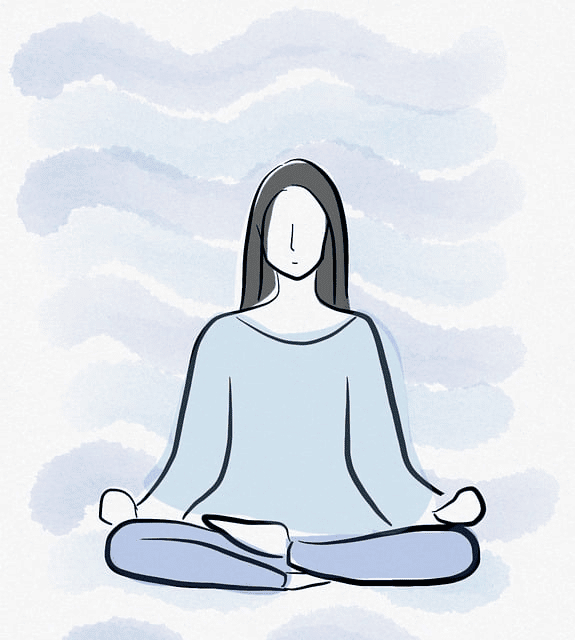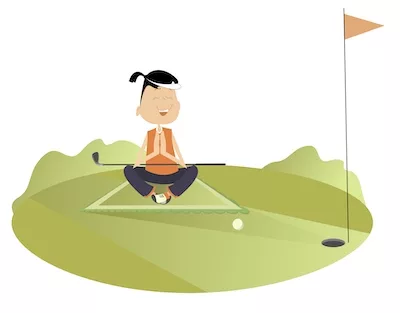Loud, rude players. Big crowds. Itchy shirt. Leaderboard anxiety.
There are many distractions on the golf course capable of derailing even the most poised player on the PGA tour. We’ve seen golfers in playoff positions crumble with no sign of weakness in the initial rounds.
How can you combat the enviable stress of playing well? How can you play and avoid negative thoughts? Can you control your response to distractions?
I’m going to share strategies I learned from sports psychologists when I was at the Olympic Training Center preparing for the 1996 games.
There are mental tools useful in relieving anxiety and preparing you to play well. The practice of meditation and being mindful are the best ways to calm your nerves, especially when playing well.
Benefits of Meditation for golfers
Meditation can improve the entire golf experience and perhaps even your general disposition.
With proper mediation practice, a golfer can learn to control a part of the game others ignore. The mental game.

Mediation prepares your entire body for high-pressure situations and ideally produces a more controlled response to stressors. According to a study by Blankert & Hamstra from 2016, Tennis players who performed visualization exercises prior to an activity performed better after the visualization (source) .
“All individuals, regardless of age, gender, or skill level, are capable of using imagery as a means to enhance cognitive, behavioral, and affective outcomes. In the sport domain, athletes use imagery in training, competition, and rehabilitation.”
Munroe-Chandler KJ, Guerrero MD. Psychological imagery in sport and performance.
The brain doesn’t know the difference between visualizing hitting a perfect shot and physically hitting a perfect shot.
How golfers should meditate
Meditation for golf involves visualization and relaxation techniques.
I like to sit eyes-closed in a comfortable chair with soundproof headphones. Others prefer music or nature sounds during their practice. Experiment and find what environment allows you to focus best.
It is completely normal to drift in and out of focus. Short sessions will increase your confidence to maintain focus but don’t give up! Take a break and try again later if you find a particular session ineffective.
Tailor it to your own situation

Tailor your meditation scenario to the actual golf game you will be playing. Make your mental golf practice real and relevant.
Visualize and rehearse the event or sequence of events. Everything is perfect. You feel confident and every movement is effortless. You should be performing perfectly in your minds-eye. Your technique and results are perfect.
Beginners could start with one hole and run through possible scenarios. Advanced mental golf practitioners could run through an entire tournament prior to play.
The most difficult part of mediation is truly immersing yourself. You should see the golf course, smell the grass, hear the buzz of activity around you, and feel the club in your hands.
Put yourself in situations you know are likely to occur and visualize the best outcome. And when the situation occurs on the course, you’ve already been there and know how to achieve the successful, desired outcome. A huge advantage!
I like to spend 20 – 30 minutes before an important round of golf. I’ll visualize the other players, the course, and most importantly, myself performing perfectly. I find that when I have a really good meditation session, I play some of my best golf. I feel more confident and get less irritated when I hit a bad shot.
Guided Meditation
Watch our exclusive guided meditation tailored for golfers to enhance focus and performance on the course!
I have put together a guided meditation in this short 5 minute video to help you understand the thought process and to help you visualize playing a perfect hole. It can take time to become proficient, but work your way up to playing an entire round of golf in your head.
You’ll play some of your best golf when you do! I try to do this within an hour or two of playing.
When to Practice Meditation
When should you practice? While you are learning the art of meditation, you should practice at least daily for a minimum of 10 minutes.
As you progress, you will be able to extend the practice longer and make the session more elaborate.
Practice in a quiet environment conducive to concentration. Maintaining your focus during mental exercises will be difficult at first so keep distractions to a minimum.
Meditation Takes Time (pun intended)

Effective mediation takes dedication and much practice. Practice with perfection as the goal but expect to put much time into practice and application.
Try to practice and apply for a few months before assessing the effectiveness. Some players will progress faster than others. And be honest about your experience. Perhaps you are not playing five strokes better, but are you feeling more relaxed in tournaments or match play?
I will confess I took several years to feel I was an accomplished mental athlete; however, the benefit to my performance was very noticeable along the way.
Differences in Meditation, Mindfulness, and Hypnosis
There are subtle differences between meditation and mindfulness. As we’ve covered meditation previously, mindfulness is more of a section of time focused on being present and aware.
Mindfulness for golf can be conducted as consciously and deliberately moving through your practice or round while keeping a tight mind and body connection. There’s no good or bad critique of your golf practice; you are simply there and executing. Being mindful avoids negative thoughts and unburdens your mind.
Mindfulness complements meditation practice and can be practiced throughout the day in any situation. There is no downside to practicing either or both of these techniques to improve your golf game.
Golf Hypnosis
Golf hypnosis is a psychological technique that aims to improve a golfer’s performance on the golf course through the use of hypnosis. Hypnosis is a state of focused attention, heightened suggestibility, and deep relaxation.
During golf hypnosis, a trained hypnotist or a golfer may use self-hypnosis techniques to access the golfer’s subconscious mind and influence their thoughts, beliefs, and behaviors related to golf.
Visualization is a key component of golf hypnosis. The individual is encouraged to vividly imagine themselves playing golf with precision and success. This mental rehearsal helps create a positive mental blueprint for actual performance on the course.
If you are new to visualization and meditation, putting yourself into a deep state of meditation or hypnosis may be difficult. Work through the visualization exercises recommended above and as you get more proficient you’ll have the ability to go deeper.
Self-Hypnosis Techniques
- Relaxation and Breathing:
- Find a quiet, comfortable place to sit or lie down.
- Close your eyes and take deep, slow breaths.
- As you breathe in, imagine inhaling relaxation and positive energy.
- As you exhale, release tension and negativity.
- Progressive Muscle Relaxation:
- Start at your toes and work your way up, focusing on each muscle group.
- Tense each muscle group for a few seconds and then release, feeling the tension melting away.
- Progressively move up through your body until you’ve relaxed all muscle groups.
- Visualization:
- Imagine a peaceful, serene place or scenario. It could be a golf course, a beach, a forest, or any place where you feel calm and content.
- Engage all your senses in the visualization—see, hear, smell, taste, and touch the details of your chosen place. (This is what the guided meditation above helps you do for a golf course)
- Positive Affirmations:
- Create a list of positive affirmations that reflect your goals or desires.
- Repeat these affirmations to yourself during your self-hypnosis session.
- Believe in the statements as you say them, allowing them to influence your subconscious mind positively.
- Counting and Deepening:
- Counting can help induce a hypnotic state. You can count backward from 10 to 1, visualizing yourself descending a staircase with each number.
- As you count, tell yourself that you are becoming more relaxed and focused.
- Guided Imagery:
- Use guided imagery recordings or scripts that take you through a specific scenario or journey designed to achieve your goals.
- You can use our guided self-hypnosis session or create your own personalized scripts.
- Create an Anchor:
- Choose a specific word, phrase, or physical touch (like pressing your thumb and forefinger together) that you associate with a desired mental state.
- Use your anchor during your self-hypnosis practice to trigger that state whenever you need it in real-life situations.
- Set Clear Intentions:
- Before starting your self-hypnosis session, clearly define your goal or intention. What do you want to achieve through self-hypnosis?
- Keep this intention in mind throughout your session.
- Regular Practice:
- Like any skill, self-hypnosis improves with practice. Set aside dedicated time for self-hypnosis sessions and be consistent in your efforts.
- Stay Patient and Open-Minded:
- Understand that self-hypnosis may take time to yield noticeable results.
- Be open to the process and trust in your ability to influence your subconscious mind positively.
FAQs
Final Thoughts
It is going to take some time and discipline, but if you apply these techniques and practice daily, you’re well on your way to seeing positive results!
These visualization techniques are going to be critical to execute during your pre-shot routine.
Good luck on the golf course, and please let me know if you find these tips helpful.
